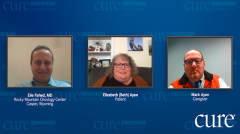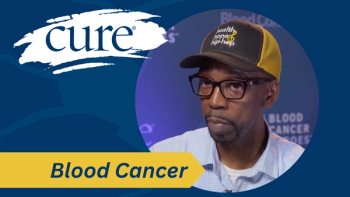
Multiple Myeloma Diagnosis: The Beginning of Beth’s Story
Elie Fahed, MD, provides an overview of what multiple myeloma is, and Beth walks us through her frustrating journey to initial diagnosis as an atypical patient.
Episodes in this series

Elie Fahed, MD: Hello, and welcome to CURE® Expert Connections®. I am Dr. Fahed. I am a hematologist-oncologist. I am happy to be here today with my patient Beth Ayen and her husband, Mark. Welcome, Beth. Welcome, Mark.
Elizabeth Ayen: Thank you.
Elie Fahed, MD: Beth and Mark will share with us their story with multiple myeloma. You will see it is quite an unusual success story that will be beneficial for everyone to hear about and learn from. Multiple myeloma is a rare condition, a rare bone marrow cancer. It is a cancer. Technically, it is a plasma cell, so it is a part of the white cells in charge of immunity. Whenever those cells become cancerous, they can overwhelm the bone marrow, cause bone pain, injure the kidneys and, eventually, lead to death. Beth has an unusual story. She was diagnosed 21 years ago. Beth, is that right?
Elizabeth Ayen: 23.
Elie Fahed, MD: It was 23 years ago. Wow. You were a young mother. You were 29 years old. Tell us about it.
Elizabeth Ayen: When I was first diagnosed, I was having pain between my shoulder blades. I kept going to doctor after doctor asking, “Why am I having this pain?” I went to a chiropractor, I went to a general practitioner; they just kept saying, “Oh, everybody has back pain. There’s nothing we can do about it. You just have to live with it.” After about a year of that back pain, I started having the same kind of pain in my sternum and in my skull. I just thought, “I need to do something about this.” We were able to find an orthopedic surgeon who would see me without a referral, so we went and saw him. He recommended that we have an MRI done.
As they did the MRI, he was shocked at what was happening. He did not tell us exactly what was going on, but he wanted to do a biopsy. We were thinking, “Oh, boy—this could be cancer.” We had the biopsy done, and he just said, “You are just going to have to wait until we come up with what this is.” This was the week before Thanksgiving. So we went home, and we waited for this phone call from him.
It took three or four days before he called us. Wouldn’t you say, Mark? It was about three or four days. He finally called and said, “I am going to hang up this phone. As soon as I hang up this phone, an oncologist is going to call you from Salt Lake City.” Sure enough, as soon as I hung that phone up, it rang, and it was this oncologist. I knew at that point, of course, that this was cancer. She said, “You need to…”
Elie Fahed, MD: Let me ask you, first: How long did it take from the first time you had the bone pain until you had the diagnosis? I bet it was a very frustrating time for you.
Elizabeth Ayen: It was about a year.
Elie Fahed, MD: For about a year, you were suffering and you were hurting, and everybody was blowing you off, saying, “It’s probably just muscle pain or bone pain.”
Elizabeth Ayen: Exactly.
Elie Fahed, MD: Mark, do you remember that time? What was your impression? What was your memory of that time, that first year?
Mark Ayen: I remember it being very frustrating because she was in real pain, seeing doctors, and no one was able to do anything for her. One doctor said, “Here’s a photocopy sheet of some exercises. You should do these.” Once we found out what was going on, we realized she could have possibly paralyzed herself had she done some of those exercises.
Elie Fahed, MD: Absolutely. Let me add that I was not involved in your care at that time, but your presentation at such a young age is very atypical. You probably know by now that the majority of my myeloma patients are in their 70s and 80s. They present with abnormalities on blood work. Some of them present with bone pain like you. Others present with kidney failure. Rarely do we see a patient in their 20s presenting with multiple myeloma. At that time you got a call. You were told, “I think you have compression of your spine.” Let us know how urgent it was.
Elizabeth Ayen: We went down there. We had to drop our kids off in Evanston, Wyoming, and then we rushed to Salt Lake City from there. They were waiting for us and had a room starting to be set up on the oncology floor. This doctor walked in—who we found later was the radiation oncologist—and she asked the nurse at the desk, “Where is Mrs. Ayen?” She said, “She is right there.” The doctor said, “No, there is no way she could be there.” She comes over to me and says, “Can you walk?” I said, “Yeah. I have been cleaning my house. I’ve been doing all kinds of stuff today, getting ready for Thanksgiving.” She said, “Well, you should not be able to walk or use your arms. You have a cord compression at your T3 vertebra, and it is completely compressed.” They just very carefully took me to my room and said, “You are not moving unless you need to use the restroom.” The regular oncologist came in, and she basically told me that they think it is multiple myeloma, which I had never heard of before.
Elie Fahed, MD: Let me chime in here to give a message to our listeners. Back pain can be serious. I think—Beth, you probably know now that you were within hours of losing control of your arms and legs if the compression was not treated immediately. That is why they took you so urgently. It is very important to a lot of patients if they have back pain. I have seen this happen time and time again. Patients waste a year going to chiropractor after chiropractor getting exercises. I am sure they at times are right, that it is just benign back pain. But every now and then it is real myeloma. It can be insidious. It is hard to diagnose. If you have that back pain—you are not sure what it is, it is not going away, or it doesn’t feel right—always ask to see a physician. Always ask for an MRI or some sort of imaging; make sure there is no compression, that there is no impending neurological damage to you.
This transcript was edited for clarity.





